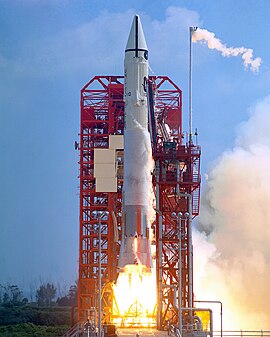Atlas Centaur

An Atlas-Centaur launching Surveyor 1
|
|
| Function | Expendable launch system |
|---|---|
| Manufacturer |
Convair General Dynamics |
| Country of origin | United States |
| Launch history | |
| Status | Retired |
| Launch sites |
LC-36, Cape Canaveral SLC-3E, Vandenberg |
| Total launches | 197 |
| Successes | 181 |
| Failures | 13 |
| Partial failures | 3 |
| First flight | 8 May 1962 |
| Last flight | 31 August 2004 |
The Atlas-Centaur was an American expendable launch system derived from the SM-65 Atlas D missile. Launches were conducted from Launch Complex 36 at Cape Canaveral Air Force Station, Florida.
Convair, the manufacturer of the Atlas, developed the Centaur upper stage specifically for that booster, sharing its inflated balloon skin. It was also the first production rocket stage to utilize liquid hydrogen (LH2) and liquid oxygen (LOX) as propellant. Despite high performance, LH2 nonetheless had problems because it had to be chilled at extremely low temperatures (lower than LOX) and its light molecular density meant that large fuel tanks were needed.
The first attempt at using a LH2/LOX-fueled engine was the Air Force's top-secret Lockheed CL-400 Suntan reconnaissance aircraft program in the mid-1950s, but it was judged too unsafe, expensive, and impractical for that purpose. However, the progress made during the aborted venture was picked up by Convair and others for rocket stage use. Originally, Centaur was conceived of as a purely experimental project to develop experience for larger, more powerful rocket stages and not given a definitive mission, so as not to distract Convair's focus on the all-important Atlas program. Although originally under ARPA supervision, Centaur was transferred to NASA in July 1959, eleven months after the program's inception. However, the Air Force retained ultimate supervision in part because they intended to use Centaur for an ambitious network of military communications satellites known as ADVENT. A constellation of ten satellites would provide round-the-clock instant communications for the three main branches of the US military. The first three would be launched on an Atlas-Agena, then the remainder on Centaur. ADVENT never got off the drawing board, but Centaur quickly found a use for several NASA planetary probe projects, namely Mariner and Surveyor.
Convair developed a specially-enhanced version of the Atlas D vehicle for mating with Centaur stages; the Atlas's engines were upgraded and the structure reinforced for the large upper stage, along with elongated fuel tanks. Centaur development was made somewhat difficult by the insistence on modifying Atlas components rather than develop totally new ones. This was done for time and budget reasons and because it allowed the Centaur to be manufactured on the existing Atlas assembly line at Convair. The engines were manufactured by Pratt and Whitney. There were considerable difficulties integrating the two vehicles, especially because Atlas-Centaur would be almost 30% longer than an Atlas ICBM and there were doubts as to its aerodynamic stability in flight.
...
Wikipedia
